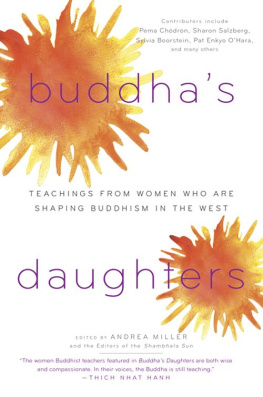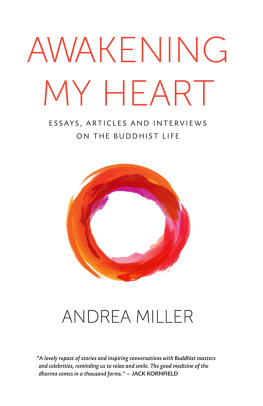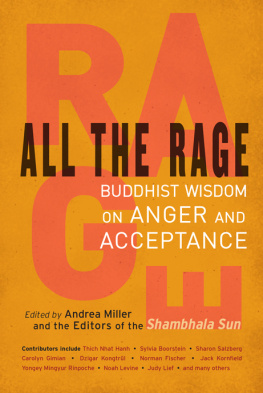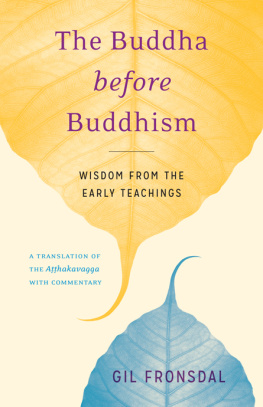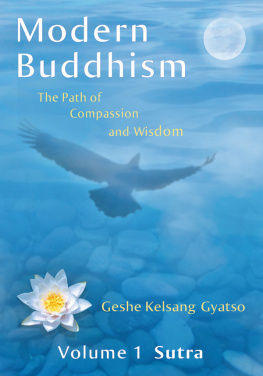ABOUT THE BOOK
Buddhism, like all world religions, has been largely shaped and defined by men. Yet despite the challenges, women have diligently practiced since the days of the Buddha. A hallmark of Western Buddhism is the prominent role that women teachers play. Buddhas Daughters showcases women teachers who have been pivotal in shaping Western Buddhism and reveals the incredible diversity of their teachings. The pieces in this book touch on universal truths as well as illuminate Buddhist concepts and practices, such as meditation, tonglen, lovingkindness, cultivating gratitude, and social action as seen through a Buddhist lens.
ANDREA MILLER is an editor and staff writer for Shambhala Sun magazine.
Sign up to receive news and special offers from Shambhala Publications.

Or visit us online to sign up at shambhala.com/eshambhala.
Buddhas Daughters
Teachings from Women Who Are Shaping Buddhism in the West
Edited by Andrea Miller and the editors of the Shambhala Sun


SHAMBHALA BOSTON & LONDON 2014
Shambhala Publications, Inc.
Horticultural Hall
300 Massachusetts Avenue
Boston, Massachusetts 02115
www.shambhala.com
2014 by Andrea Miller
Cover illustration istockphoto
Cover design by Kathleen Lynch/Black Kat Design
All rights reserved. No part of this book may be reproduced in any form or by any means, electronic or mechanical, including photocopying, recording, or by any information storage and retrieval system, without permission in writing from the publisher.
Library of Congress Cataloging-in-Publication Data
Buddhas daughters: teachings from women who are shaping Buddhism in the West / edited by Andrea Miller and the editors of the Shambhala Sun.First Edition.
pages cm
eISBN 978-0-8348-2965-7
ISBN 978-1-59030-623-9 (pbk.: alk. paper)
1. BuddhismDoctrines. I. Miller, Andrea, editor of compilation.
BQ4165.B795 2014
294.342dc23
2013017801
Contents
I HAD MY first taste of Buddhism in university when I took a class on Chinese and Japanese religions. Since the presentation was dryly academic, I didnt immediately connect with the Four Noble Truths. Truth be told, I can barely remember taking notes on them, but what did spark my interest was the dissemination of Buddhism. My professor explained that as the Buddhas teachings fanned out across Asia, they took on the flavor of each culture they encountered. And the resultfrom Tibet to Thailand and beyondwas that Buddhist traditions came to be so varied that early Western colonialists and missionaries were not always aware they embodied a single religion.
My professor did not go on to address modern Buddhisms state of fluxthat was beyond the scope of our class. Yet Buddhism is indeed still transforming. Now its taking root in the West, and decade by decade its developing into its own Western strain, or strains. Admittedly, the results are mixed. Its uncomfortable, for instance, to see the Western vice of materialism seeping into Buddhist practice. But to date there is one hallmark of Western Buddhism that I believe is cause for unreserved celebration. In the West, women teachers play a prominent role; their wise voices are strong and getting stronger.
Some critics have claimed that to place importance on there being women teachers is to inappropriately genderize the dharma. As I see it, however, its actually a small step in degenderizing it. Though the Buddha taught that at the ultimate level there is neither male nor female, at the relative level thats far from the case. Beyond just having different bodies, we are socialized differently and accorded different roles and privileges. In a myriad of ways, these factors determine how we experience the world and, by extension, how we experience the spiritual path. So, while both male and female teachers can speak on the universal human experience, women can also have a unique perspective that can be helpful to both male and female students.
Yet Buddhism, like all world religions, has largely been shaped and defined by men. Century after centuryright up to the present daywomen have been denied teachings and ordinations and have found themselves relegated to monastery kitchens. Theyve been deemed to be of lower birth, and in some lineages even the most experienced, aged nun must bow before any monk, even the youngest, least experienced among them. Blocked by such discrimination, women have had limited opportunities to develop into advanced practitioners and teachers. Yet despite the challenges, women have diligently practiced from the beginningsince the days of the Buddha. I hope this anthology serves as an inspiration for contemporary women practitioners.
Buddhas Daughters honors women teachers who are pivotal in shaping Western Buddhism and showcases the incredible diversity of their teachings. The bookorganized alphabeticallybegins and ends with pieces that introduce us to women ancestors. In Meeting the Demon, Tsultrim Allione introduces us to Machig Labdron, an innovative eleventh-century yogini who deeply influenced the development of Vajrayana Buddhism. Then in We Cannot Stop the Hail, but We Can Be Awake, Bonnie Myotai Treace lyrically evokes the poetry and practice of Rengetsu, a Pure Land Buddhist nun who is considered one of the greatest Japanese poets of the nineteenth century.
Between these two bookend pieces, the teachings presented are so broad both stylistically and thematically that its difficult to tidily pinpoint them as feminine or not. Personally, I prefer not to limit them with labels. These teachings touch on universal truths. Though theyre all by women, I believe they are each as universal as any one voice can ever be.
In this anthology, Buddhist concepts and practices are the focus. Sylvia Boorstein, for instance, unpacks her fresh take on the traditional teachings of the three marks of existence, while Pema Chdrn offers a heartfelt teaching on tonglen, a practice for developing compassion.
Practices that help bring mind and body into alignment are foundational. For Jan Chozen Bays, whats on our plates is the vehicle. Bite by bite, moment by moment, how do we experience taste, texture, color, scent, sound? Can we be curious and playful as we investigate our responses to food and what really satisfies our deepest hunger? Then Sister Chan Khong leads us through a simple yet powerful meditation on the body. Soften the shoulders, feel the breath, rest the eyes, she says. A relaxed body is a relaxed mind.
In addition to valuing womens voices, Western Buddhism is further characterized by having a large number of lay teachers, and the teachings in this anthology reflect that. Here we see teachings that are both profound and highly practicalfully grounded in lay life, including intimate relationships. Notably, Karen Maezen Miller explores the arc of romance. Love that lasts allows the love story to end, she says. It isnt laden with romantic fantasies or regret; its not defined or limited, not stingy or selfish. The love story always ends eventually, but that doesnt necessarily mean a messy breakup. It can, instead, signify the beginning of a real and enduring love.
How to deal with difficulties is addressed in many different ways by the teachers in this collection. In The Scenery of Cancer, Darlene Cohen teaches by recounting her moving, intensely personal story of practicing with illness. Judith L. Lief, on the other hand, offers us a comprehensive tour de force that explains the source of stress or suffering from the Buddhist perspective.
Next page
